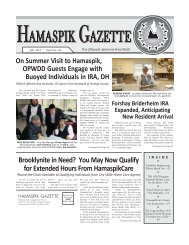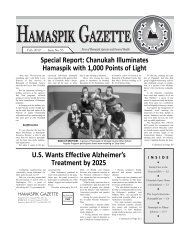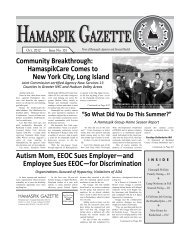108 yiddish english color.qxd - Hamaspik.org
108 yiddish english color.qxd - Hamaspik.org
108 yiddish english color.qxd - Hamaspik.org
Create successful ePaper yourself
Turn your PDF publications into a flip-book with our unique Google optimized e-Paper software.
PUBLIC HEALTH<br />
and POLICY NEWS<br />
Your Fragile X queries at<br />
OPWDD’S IBR<br />
The Institute for Basic Research in<br />
Developmental Disabilities (IBR), a Staten<br />
Island-based division of the New York State<br />
Office for People With Developmental<br />
Disabilities (OPWDD), held a one-day conference<br />
on Fragile X syndrome—centered around<br />
questions on Fragile X treatment strategies<br />
sent in by before the event.<br />
The conference, held April 7, featured<br />
Fragile X experts Lauren Moskowitz, Ph.D. of<br />
the New York University Child Study Center,<br />
the IBR’s Vicki Sudhalter, Ph.D., and Laurie<br />
Yankowitz, Ed.D. of HeartShare Human<br />
Services of New York addressing specific<br />
questions on Fragile X behavior, language<br />
development, sensory integration and more.<br />
The event, which was co-sponsored by the<br />
National Fragile X Foundation and the Fragile<br />
X Associations of New York and New Jersey,<br />
was attended by over 75 parents, therapists and<br />
caregivers of individuals with the genetically<br />
caused disability.<br />
Retail clinics: medicine’s next<br />
big thing?<br />
Need non-emergency medical care? Go to<br />
the mall.<br />
Selling so-called convenient care where<br />
everything else is sold, especially at national<br />
chain pharmacies, big-box stores and even<br />
retail mall storefronts, is a growing wave of<br />
the future.<br />
Convenient care is exploding for several<br />
reasons:<br />
• Insurers are now covering vaccines and<br />
family physicals at convenient care clinics<br />
• More consumers are looking for cheap<br />
alternatives to high-deductible private insurance<br />
• Millions of first-time ensurees in 2014 by<br />
ObamaCare will flock to convenient routine<br />
medical care at local pharmacies and shopping<br />
malls instead of traditional doctors’ offices<br />
• In delivering many services by onsite<br />
licensed pharmacists or nurse practitioners,<br />
retail chains offer a low-cost alternative to the<br />
traditional doctor’s-office/pharmacy visit<br />
According to the Convenient Care<br />
Association estimates, there are now over<br />
1,400 health clinics inside retail chain stores<br />
nationwide—double the number from six<br />
years ago. These include 650 MinuteClinics<br />
in 25 states run by CVS, and Walgreens’ 372<br />
Take Care clinics. CVS plans 1,500 clinics in<br />
35 states by 2017 (with 150 to open in 2013<br />
alone), and Walgreens is planning double-digit<br />
growth in 2013. Target and other retailers,<br />
and even some mainstream providers, are following<br />
suit—including opening mall storefronts.<br />
But convenient care providers are moving<br />
to offer much more than flu shots. Walgreens,<br />
for example, recently began offering assessment,<br />
treatment and management of asthma,<br />
diabetes, hypertension and other chronic conditions.<br />
Walgreens is also pivoting to meet another<br />
major industry change: The move from the<br />
current fee-for-service medicine (i.e. responsive<br />
medicine) to accountable care <strong>org</strong>anizations<br />
(ACOs), (i.e. preventive medicine). As<br />
such, its Take Care clinics are now allied with<br />
three ACOs, which many see as the healthcare<br />
delivery system of the future.<br />
“The big shift that I see in the landscape is<br />
from one that has historically been a pay-foruse<br />
model to one that is really starting to center<br />
around outcomes in healthcare,” said<br />
Walgreen CFO Wade Miquelon—also predicting<br />
that pharmacists will begin writing prescriptions<br />
for certain categories of drugs.<br />
But one downside to nationally-branded<br />
retail convenient care is just that: Branding.<br />
One medical error by a single branch could<br />
ripple-effect the entire chain nationwide.<br />
Violate the ADA law? Pay<br />
$240 million<br />
In the largest-ever monetary award ever<br />
obtained in a lawsuit by the U.S. Equal<br />
Employment Opportunity Commission<br />
(EEOC), 32 disabled employees of the Texasbased<br />
Henry’s Turkey Service were awarded<br />
$2 million in punitive damages and $5.5 million<br />
in compensatory damages each, for a total<br />
of $240 million.<br />
The federal jury found that the men had<br />
endured years of employee abuse and discrimination,<br />
substandard living conditions, verbal<br />
and physical harassment and denial of medical<br />
care.<br />
“The verdict sends an important message<br />
that the conduct that occurred here is intolerable<br />
in this nation, and hopefully will help to<br />
restore dignity and acknowledge the humanity<br />
of the workers who were mistreated for so<br />
many years,” said EEOC chair Jacqueline<br />
Berrien.<br />
Less hours, more shifts,<br />
equal patient risk<br />
According to a new study in the Journal of<br />
General Internal Medicine, restricting the<br />
number of hours doctors-in-training are<br />
allowed to work without rest hasn’t led to<br />
more patient fatalities.<br />
In 2003, concerns over errors caused by<br />
sleepy residents at hospitals led the<br />
Accreditation Council for Graduate Medical<br />
Education (ACGME) to restrict doctors-intraining<br />
to working a maximum of 80 hours<br />
per week. The ACGME again restricted residents’<br />
working hours in 2011, when it said<br />
shifts can last no longer than 16 hours for the<br />
least-experienced doctorssis.<br />
The new limits prompted concerns that<br />
more changing of patient caregivers, the more<br />
errors. But researchers found no such increase<br />
over the three years following a rules change<br />
that restricted resident doctors’ maximum<br />
weekly hours to 80. In fact, the team reports a<br />
decline during the fourth and fifth years.<br />
Back-to-back national Head<br />
Start conferences<br />
The Office of Head Start held its 2nd<br />
annual National Birth to Five Leadership<br />
Institute Conference this past April 28-30 in<br />
National Harbor, Maryland, seguing directly<br />
into the National Head Start Association<br />
(NHSA)’s 40th annual national conference<br />
April 30-May 3 in Washington, D.C. The<br />
Head Start program, like the Early Intervention<br />
program offered by <strong>Hamaspik</strong>, is relied upon<br />
by many in <strong>Hamaspik</strong>’s target communities for<br />
critical kids’ services.<br />
FDA after chewing gum?!<br />
Seems that Wrigley’s bit off more than<br />
they could chew, and that the FDA has a bit of<br />
catching up to do.<br />
In response to ever-proliferating products<br />
containing ever-rising levels of caffeine—<br />
some dangerously so—the FDA is now apparently<br />
scrambling to protect the public, particularly<br />
youth.<br />
Among the bizarre array of (some-heavily)<br />
caffeinated food products currently being marketed<br />
to kids and teens, apparently (and tragically)<br />
in response to ever-increasing demand,<br />
are jelly beans, marshmallows, sunflower<br />
seeds, waffles, waffle syrup (!), oatmeal (!!)<br />
and even the new Alert Energy Caffeine Gum<br />
from the iconic Wrigley’s. (But after conferring<br />
with the FDA, Wrigley’s pulled Alert production,<br />
sales and marketing on May 8.)<br />
According to the FDA, existing rules never<br />
anticipated the current proliferation of caffeinated<br />
products.<br />
In early May, the FDA announced that it<br />
will be investigating the safety of caffeine in<br />
these products, particularly its effects on children<br />
and adolescents. The announcement<br />
comes against the background of ongoing<br />
aggressive marketing of caffeine-laced and<br />
unhealthy so-called “energy drinks”—itself in<br />
the wake of increasing ER visits and hospitalized<br />
caused by overdose or abuse of such<br />
products.<br />
Second weak jobs month for<br />
healthcare<br />
According to the U.S. Bureau of Labor<br />
Statistics, job creation at physician offices<br />
rebounded and helped contribute to 19,000<br />
new healthcare jobs in April, but the figure<br />
represents a second month that the sector made<br />
a relatively weak contribution to the job market.<br />
Healthcare employers added 9,900 fewer<br />
jobs in March compared with February, and<br />
the number held steady last month.<br />
The industry, though, has been a reliable<br />
source of jobs during the economy’s tepid<br />
recovery. The sector added 268,700 jobs since<br />
April 2012, an average of about 24,000 a<br />
month.<br />
Med schools on pace with<br />
enrollment target<br />
As the U.S. faces a shortage of physicians—potentially<br />
more than 90,000 by<br />
2020—medical schools are seeking to counteract<br />
the deficiency with higher enrollments.<br />
In 2006, the Association of American<br />
Medical Colleges (AAMC) issued a recommendation<br />
to expand medical school enrollment<br />
by 30 percent over its 2002 level of<br />
16,488 students by 2015.<br />
Now, according to the AAMC’s most<br />
recent Medical School Enrollment Survey,<br />
first-year medical school enrollment is expected<br />
to meet that goal in 2017-18 with 21,434<br />
enrollees. The announcement is welcome<br />
news in light of an expected physician shortage<br />
come the 2014 full roll-out of ObamaCare,<br />
when an estimated additional 30 million more<br />
people will get Medicaid.<br />
Feds and dogs<br />
In a late-April update, the U.S. Dept. of<br />
Housing and Urban Development (HUD)<br />
underscored that landlords must allow “reasonable<br />
accommodations” for service animals,<br />
such as seeing-eye dogs, used by disabled<br />
renters—and that standard pet restrictions<br />
don’t apply to them. The federal agency’s top<br />
received complaints are disability-related.<br />
Reverse discrimination suit at<br />
deaf-friendly apts.<br />
So you build an apartment building, one of<br />
the only ones of its kind in the nation, outfitted<br />
with all the latest deaf-friendly technology,<br />
and invite deaf people to move in. Problem is,<br />
the government says that by doing so, you’re<br />
discrimiwnating against people who are not<br />
deaf.<br />
That’s the issue at the heart of the legal<br />
battle now swirling around Apache ASL Trails,<br />
a housing complex for seniors in Tempe,<br />
Arizona that was partially built with federal<br />
funds: Because 69 of the 75 units are occupied<br />
by the deaf and hard-of-hearing, the federal<br />
Dept. of Housing and Urban Development<br />
(HUD) is now looking into whether the developer<br />
has run afoul of any law. The case has<br />
yet to be settled.<br />
Feds: Novartis bribed docs to<br />
pitch drugs<br />
Swiss drug giant Novartis has been<br />
accused by federal prosecutors of engaging in<br />
a massive and costly <strong>org</strong>anized kickback<br />
scheme to essentially bribe doctors to prescribe<br />
its brand-name drugs hypertension and<br />
diabetes drugs. The government alleges that<br />
Novartis salespeople treated doctors nationwide<br />
to lavish dinners, fishing trips and other<br />
perks in exchange for their favored recommendation<br />
of Novartis drugs. The lawsuit, filed in<br />
Manhattan federal court, is ongoing.<br />
Less juice,<br />
same program<br />
Recipients of the USDA’s Special<br />
Supplemental Nutrition Program for Women,<br />
Infants and Children—known informally as<br />
WIC—have since October 2009 been able to<br />
purchase less than half the juice previously<br />
permitted on the public-welfare program. A<br />
study by Yale University now says that the<br />
reduced allowance has not simply driven<br />
recipients to purchase juice or other sugary<br />
drinks—a leading culprit in the national obesity<br />
epidemic—elsewhere; instead, they seem to<br />
be actually drinking less juice.<br />
<strong>Hamaspik</strong> Gazette | April/May ‘13<br />
E11

















